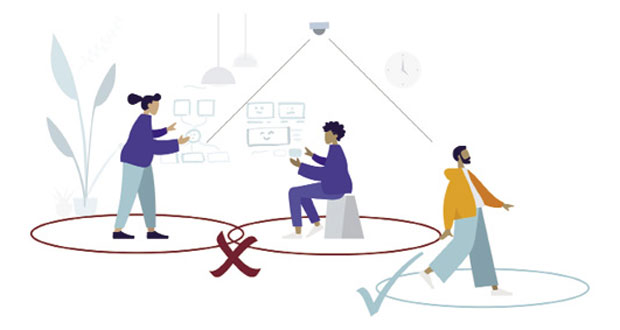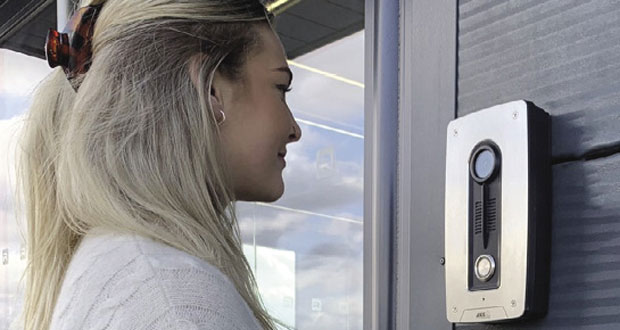As lockdown eases and people travel back into the office, Leanne Beeken, Head of Business Communications Technology at Remark Group looks at the range of technologies available to support worker wellbeing
With the roadmap out of lockdown underway, reassuring occupants that the workplace is a safe place will be essential for FMs to consider when planning the reopening of the workplace. Adjusting to both returning to the workplace and the way it must now be organised, may present challenges for the wellbeing of the UK workforce, so as businesses begin to operate their return-to-the-workplace strategy, FMs should not only address the physical space but consider how to make the transition as stress free for occupants as possible.
The current Government guidance for offices is to consider the mental health and wellbeing aspects of COVID-19, alongside preventative measures, such as making sure everyone is social distancing. To sustain this, businesses can look to technology solutions to help them adapt their working practices.
WELLBEING ZONES
Employers want employees to feel safe and comfortable in the workplace; however, some groups of workers may feel a sense of anxiety regarding their return to work, after getting used to working at home. It is no secret that access to nature can help reduce stress levels and help improve our overall wellbeing; but for those commuting back into cities and built-up areas, being no longer able to experience nature can be hard, particularly during the working day.
This is where it may be worth considering the use of Soundscapes to create acoustic comfort. Wellbeing Soundscapes enable employees to listen to sounds inspired by nature as they work and are the perfect way to provide employees with a sense of wellbeing and comfort. Installing Soundscapes in open plan offices, or to create wellbeing break-out zones is a great way of benefiting from nature’s soothing effects to help make your employees feel more at ease. When blended with Sound Masking they can have the additional benefit of enhanced privacy.
COMPENSATE FOR WORKING HABITS
When employees return to their familiar working environment, due to overfamiliarity with the space they may find that they slip into old habits like standing too close to other occupants.
To overcome this and support social distancing, you can reduce the risk of COVID-19 by integrating network cameras into Social Distancing Detection technology. This solution detects hotspots to help identify places where improved social distancing methods should be implemented, such as busy corridors or queues within breakout or catering areas.
The data provided can help decide where other measures, such as stop and go Occupancy Systems or health and safety Digital Signage (see below) should be integrated. Employees will ultimately be reassured that provisions are being implemented to support their return to work.
OCCUPANCY LEVEL MANAGEMENT
Scheduling breaks to minimise bottlenecks in shared spaces may be one behavioural technique to achieve occupancy level management. This will be particularly useful during high-footfall periods, when more people will be moving around the premises. However, hybrid and flexible working may present challenges for FMs attempting to monitor and sustain the advised occupancy levels.
Electronic people counters can help control occupancy levels in any area of your workplace and help to determine how many people are in an area at one time, reassuring employees that the risk of over-crowding is reduced. The solution can be integrated to display real-time notifications on digital signage displays, which can signal clear stop and go instructions, which is ideal for high traffic spaces like canteens and the front-of-house.
Digital Signage could even be linked to the cleaning schedule, to communicate that rooms have recently been cleaned and are available for use.
CONTACTLESS ACCESS CONTROL
Controlling access to your premises during COVID-19 is crucial to making your employees, visitors and clients feel safe. Pin codes, fobs and card readers have been popular forms of access control systems in the past, but now users will want a completely contactless solution to reduce touch.
QR Codes and biometrics are popular solutions for a contactless entry system. Upon a successful registration, the system will trigger the lock to release. This can be integrated with an automatic door that will open immediately, creating a contactless experience.
Temperature checks are integral to the health and wellbeing of all your visitors and employees, helping them to feel safer amongst their peers. Contactless Temperature Screening Cameras utilise facial recognition to measure an individual’s temperature in real-time. The solution can be integrated with a Contactless Access Control System for contactless doorway access to limit unnecessary contact with surfaces in high traffic areas.
Upon arrival, if an individual is within a pre-set healthy temperature, your access control system will be alerted, allowing the visitor or employee to enter the building. This allows for a seamless and quick fever detection without any physical contact.
Employees will certainly be looking to their employers for reassurance and guidance during the next stage of leaving lockdown. As measures are introduced to keep employees safe at work during this crucial period, the right technologies can help you achieve this, with the added reassurance for staff that they’re safe to be back.






